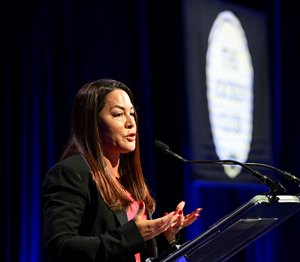Lazarus: HISA's ADMC Launch 'a Momentous Occasion'


Calling the anticipated March 27 launch of the Horseracing Integrity and Safety Authority's Anti-Doping and Medication Control Program "a momentous occasion," HISA CEO Lisa Lazarus emphasized the program's importance in a video conference with reporters March 23.
She said the first equine test samples collected under the program are likely to come Monday from either Hollywood Gaming at Mahoning Valley Race Course or Parx Racing. Both eastern tracks have first-post times around midday Monday on the anticipated start date of the ADMC Program, which, pending anticipated Federal Trade Commission approval, will begin a new era in Thoroughbred racing with centralized testing and uniform rules over much of the country.
Four states will not take part when its drug-testing procedures begin, Lazarus said. Louisiana and West Virginia are not due to a preliminary injunction issued by Judge Terry Doughty of the U.S. District Court for the Western District of Louisiana last year, and Texas and Nebraska have elected to not simulcast out-of-state rather than fall under HISA oversight.
Elsewhere, the ADMC Program "will be rolled out simultaneously on Monday," Lazarus said.
This follows last summer's implementation of HISA's Racetrack Safety Program, which created regulations related to the riding crop, horseshoes, and other matters.
HISA's critics, which include the Horsemen's Benevolent and Protective Association and some states and racing commissions, have challenged the legality of HISA in court and expressed concerns about the costs and need for a federal program. Some of those court challenges are ongoing, though HISA is on firmer legal footing after a massive federal spending bill passed this winter modified the language in the act that authorized HISA.
Some critics have expressed a preference for an interstate compact with uniform rules, though recent attempts to create such compacts have failed to generate sufficient agreement and traction.
Others have expressed confusion related to changing medication protocols, such as HISA using detection times rather than withdrawal times for therapeutic drugs.
Lazarus said HISA officials have shared goals with many critics.
"When I ask a lot of these folks like, 'What would you want out of an anti-doping program?' What they say is, 'We want to catch the cheaters. We want you to be kind of realistic and measured about medications. And we want you to understand that sometimes there are contaminants in the environment that we can't control,'" she said. "And that's exactly what our program does."
Some states will have test samples analyzed by different Racing Medication & Testing Consortium-accredited laboratories from those previously responsible for testing. Lazarus mentioned laboratories in New York and Texas—specifically the New York Equine Drug Testing and Research Program and Texas A&M Veterinary Medical Diagnostic Laboratory—as two testing facilities that will not be used under the ADMC program when it begins.
Lazarus encouraged racing participants to accept HISA whether they feel the federal government should be passing a law to create a national regulator or not.
"I really have two things to do: make sure that the program runs as smoothly and as well and efficiently and as ethically as it possibly can, and build trust," she said. "And if I can kind of get those two things—as a team I should say, it's not me personally—if we can as a team, make those things happen, I think we'll be successful. But change—I think is always hard and this is like seismic change."
